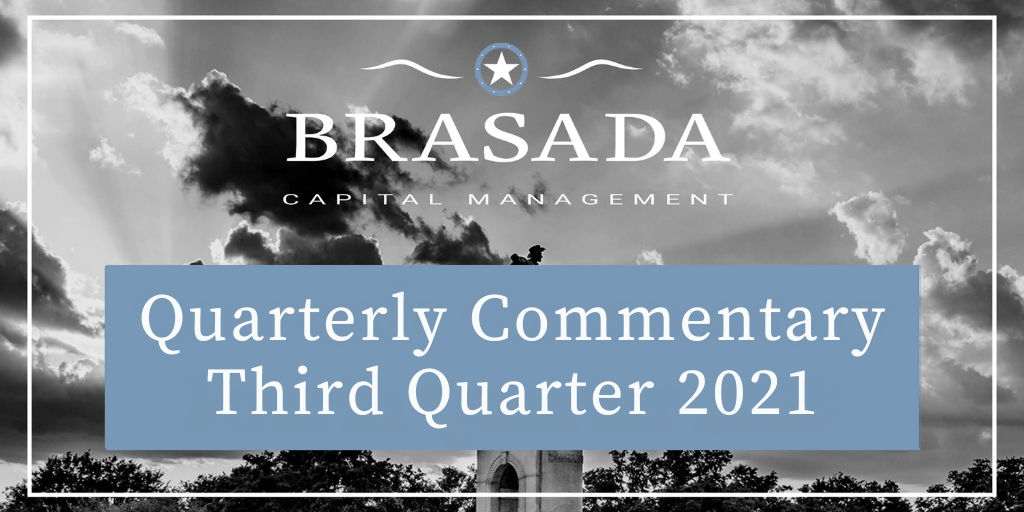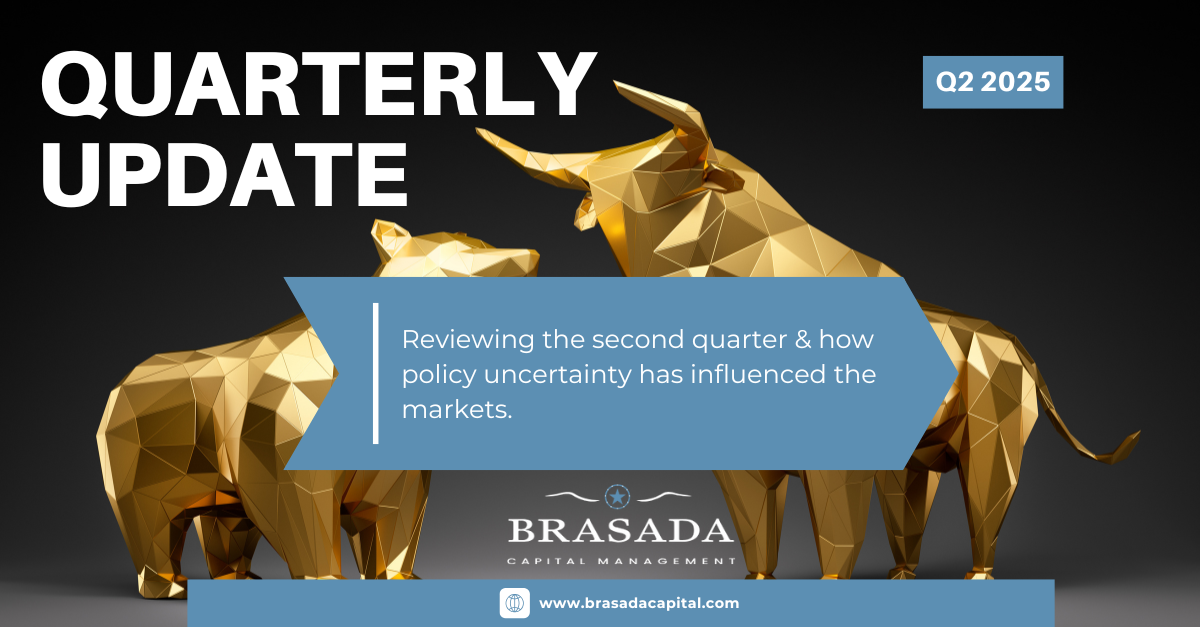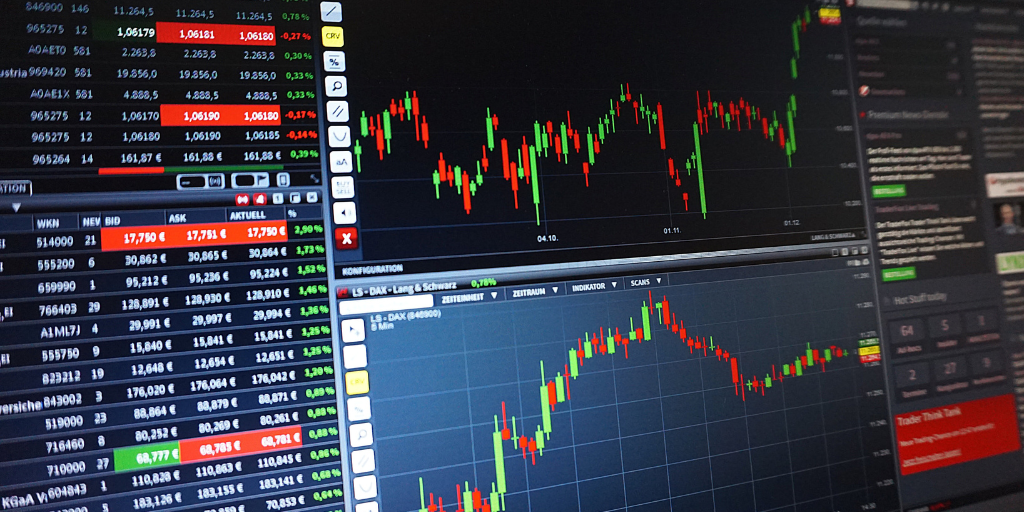Second Quarter of 2025
“Far more money has been lost by investors preparing for corrections or trying to anticipate corrections than has been lost in corrections...

During the third quarter, the market witnessed a doubling from last year’s pandemic-induced panic lows. This was the fourth fastest time for the market to gain 100% and the fastest occurrence since the Great Depression. Fueling the market has been the abundant liquidity provided starting last year, incredibly strong corporate earnings, and a slowly increasing level of confidence to resume our pre-pandemic lives.
The economic momentum experienced in the last year has more recently hit a soft patch as witnessed by falling levels of jobs added, lower consumer confidence, and supply shortages seemingly everywhere you turn. These bottlenecks are holding back growth. The demand side is there, as consumers are increasingly ready to enjoy their liberties, and they have record levels of savings from which to do so. The problem has been on the supply side and this mismatch has contributed to the highest levels of US inflation that we’ve seen in decades. With growth estimates now coming down, we see an appearance from an unwelcome condition of long ago: stagflation, or the instance of falling growth coupled with inflation. A central question now is whether the supply bottlenecks we are seeing will be short-lived or long-lived.
Challenges to companies’ supply chains had been building even before the pandemic’s onset. The incredible winter storm in Texas earlier this year caused a major disruption to the country’s petrochemical industry. Category 4 Hurricane Ida from five weeks ago aggravated that situation. Tensions with trading partners, especially China, and the imposition of new tariffs were put into place during the Trump Administration. Worker availability had been under pressure as well due to demographics: just under 9,000 baby boomers on average retired each day last year in the USA. Then, add the pressure due to a near complete shut-down of the economy, which even for a relatively short period of time, has caused major disruptions to industries such as the manufacturing of semiconductors, which then in turn adversely impacts the production of so many other products.
As an example, and one of the more visible challenges to the supply side has been in shipping. In addition to higher wages and raw material prices, shipping costs have risen substantially. Moody’s estimates that one-tenth of the increases in all US consumer prices are due to higher costs in this area. Container ships carry one quarter of the world’s traded goods by volume and 60% as measured by value. Shipping rates from Asia to the US West coast are now 5 times higher than at the same point last year and they have risen 14-fold as compared to the same time two years ago. Congestion at our ports has been a major challenge as well, and that has contributed to delays and higher costs. Shortages of truck drivers and shipping containers, coupled with higher demand for goods has increased average shipping times for ocean freight by 70% in only this year.
With the pandemic hitting last year, shipping firms expected a collapse in trade and idled 11% of their global fleets. Instead, the opposite occurred, and in the first seven months of this year, cargo volumes increased 27% compared to pre-pandemic levels. Shippers, and the entire supply chain from point-to-point has struggled to keep up ever since. Also, due to consolidation since the Great Financial Recession in 2008, the number of shipyards in the world has been reduced by 60%. Since shipping is responsible for just under 3% of carbon dioxide emissions, new regulations will come into play in 2023 which will further increase costs.
Last week, a friend from the investment business took off on a flight from the Los Angeles International Airport (LAX), and snapped this picture from his window seat (he couldn’t get all the ships in his field of view):

Apparently, the number of ships stranded off the coast of Los Angeles has worsened since then. It will take weeks or months to offload the ships now anchored off our country’s west coast, and the situation is aggravated by trucker shortages, lack of adequate space for empty containers, and this third wave of Covid which fortunately looks to now be receding. We are mindful of the risk that these supply and inflation issues take longer to resolve than expected. If so, that will negatively impact corporate earnings. The bottlenecks will indeed clear, but the issue is just how long it’s going to take to do so. In any event, we highlight what’s happening with shipping as an example of why the economy has hit this softer patch of stagflation within the continued Covid recovery. As investors, we are taking this condition into account as we place an emphasis on companies that aren’t as reliant on imports and that have pricing power to pass along higher costs so as to protect their margins.
As the quarter draws to a close, there is a good deal of uncertainty coming from Washington D.C. that can impact markets in the short-term. It should be difficult to enact the largest spending increases since the LBJ-era New Deal legislation when the Democratic majorities in Congress are so narrow and when inflation measures have been so high. There is also the potential for higher corporate, personal and estate taxes. Higher corporate taxes have the potential to reduce expected earnings growth in the S&P 500 companies from 7% to 2% next year. The debt ceiling will also need to be raised, even though the debate around that might be contentious. We should also know in the coming weeks who will be the next chair of the Federal Reserve. The Fed is also expected to begin to reduce, or “taper”, future purchases of long-term bonds through its Quantitative Easing (QE) program.
On this point, it doesn’t make any sense to us that the Fed is still buying $120 billion in long-term bonds per month through its emergency accommodation QE program, with trailing 12-month Consumer Price Index gains of 5.3% (as of Aug 31st), US residential home prices increasing almost 20%, and with so many supply bottlenecks. The Fed’s QE program is expected to end by next June, yet we wouldn’t be surprised to see it finish up sooner as the Fed looks to us as too slow to remove this liquidity. Even more important than historical readings, are the market’s expectation of future inflation, and as can be seen from the following graph, that has moved up substantially.

There has been much discussion as to whether the inflation we’re seeing is transitory or not, an in the meantime, the market must deal with this as a growing risk. The longer inflation readings run hot, the more of an impact this will have on stock multiples, especially high-growth companies whose future profitability is projected to be years into the future. So, while we have indeed had a whiff of stagflation, with consumer savings so high and new Covid case counts now falling, we expect growth to pick back up and for the supply shortages to eventually ease.
2021 started with economically sensitive stocks doing well, then as we moved onto this third Covid wave during the summer, growth expectations fell, and the market rotated to favor the same kinds of stocks that worked last year. Market returns for the third quarter were flat to negative depending on which index you see, however through the first nine months of the year, the S&P 500 Index returned 15.9% and the Russell 2000 Index returned 12.4%. On the heels of very strong 2019 and 2020 returns for our strategies, we are pleased with our composite performance, shown below and net of fees, through the first nine months:
Brasada US Equity: +20.3%
Friedberg Focused: Equity +16.3%
Friedberg Dividend Growth: +14.9%
Friedberg Equity Income: +10.5%
Historically, the market has ended well in years when performance has been this good through the first nine months. As you are adding to your accounts and opening new ones, we are putting that money to work. Interest rates this year have moved up, with 10-year US Treasuries gaining in yield from 0.87% at year-end to 1.46% by September 30th. Our firm buys municipal bonds for many of you, and that side of the market looks to have upcoming supply pressures. The federal government has provided more than $1 trillion of aid to state and local governments since Covid began, and now these entities are holding their first surplus
in 45 years. This surplus should reduce the amount of issuance and will make municipal bonds harder to locate. Demand will also increase if tax rates end up increasing.
On a final note, this quarter marked the 20th anniversary of 9/11. It’s impossible to be in our business for a long time and to not have been personally impacted by what happened. Among the many events we had to take in while at my previous employer was that a co-worker’s son lost his life. One of our Brasada teammates was also at his previous employer and worked in the area just blocks away from ground zero.We respect those who made such great sacrifices and while it was a very difficult time to process what was happening, as Americans are so great at doing in a time of crisis, we were certainly united in moving forward.
We appreciate the confidence you have placed in us and wish you the best.
Sincerely,
Mark E. McMeans, CFA
This quarterly update is being furnished by Brasada Capital Management, LP (“Brasada”) on a confidential basis and is intended solely for the use of the person to whom it is provided. It may not be modified, reproduced or redistributed in whole or in part without the prior written consent of Brasada. This document does not constitute an offer, solicitation or recommendation to sell or an offer to buy any securities, investment products or investment advisory services or to participate in any trading strategy.
The net performance results are stated net of all management fees and expenses and are estimated and unaudited. These returns reflect the reinvestment of any dividends and interest and include returns on any uninvested cash. In addition to management fees, the managed accounts will also bear its share of expenses and fees charged by underlying investments. The fees deducted herein represent the highest fee incurred by any managed account during the relevant period. Past performance is no guarantee of future results. Certain market and economic events having a positive impact on performance may not repeat themselves. The actual performance results experienced by an investor may vary significantly from the results shown or contemplated for a number of reasons, including, without limitation, changes in economic and market conditions.
References to indices or benchmarks are for informational and general comparative purposes only. There are significant differences between such indices and the investment program of the managed accounts. The managed accounts do not necessarily invest in all or any significant portion of the securities, industries or strategies represented by such indices and performance calculation may not be entirely comparable. Indices are unmanaged and have no fees or expenses. An investment cannot be made directly in an index and such index may reinvest dividends and income. References to indices do not suggest that the managed accounts will, or is likely to achieve returns, volatility or other results similar to such indices. Accordingly, comparing results shown to those of an index or
benchmark are subject to inherent limitations and may be of limited use.
Certain information contained herein constitutes forward looking statements and projections that are based on the current beliefs and assumptions of Brasada and on information currently available that Brasada believes to be reasonable. However, such statements necessarily involve risks, uncertainties and assumptions, and prospective investors may not put undue reliance on any of these statements. Due to various risks and uncertainties, actual events or results or the actual performance of any entity or transaction may differ materially from those reflected or contemplated in such forward-looking statements. The information contained herein is believed to be reliable but no representation, warranty or undertaking, expressed or implied, is given to the accuracy or completeness of such information by Brasada.

“Far more money has been lost by investors preparing for corrections or trying to anticipate corrections than has been lost in corrections...

UNDERSTANDING TARIFFS: ECONOMIC IMPACT, RATIONALE AND CONTROVERSIES

Market Selloff Dear Clients and Friends, Thursday and Friday marked the 4th time in the last 50 years when the S&P 500 had a 2-day drop of over...